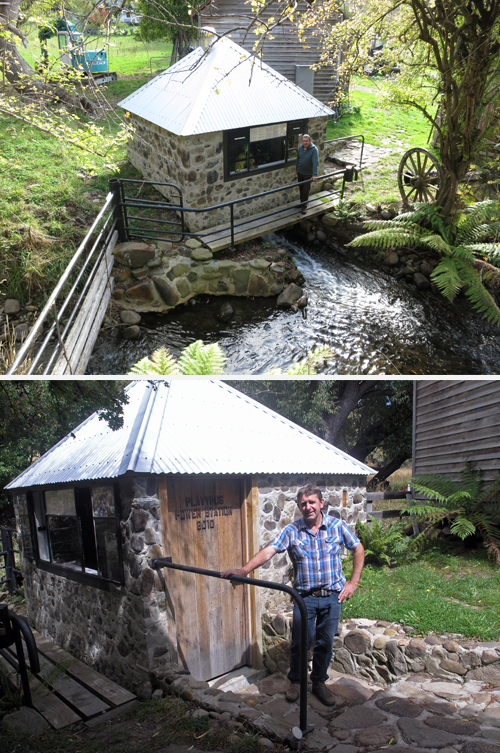Hydro power was a good idea back then, and it still is, as Nigel Tomlin is showing. [15 May 2012 | Peter Boyer]
It seemed like a pretty good idea at the time. In 1878 the world’s first hydro-electric plant near Rothbury, England, started producing power, and here in the Antipodes were all these rivers cascading from the high country to the sea. If it worked for England, why not Tasmania?
Mt Bischoff tin mines kicked off hydro power in Tasmania in 1883, only five years after Rothbury, followed within a decade by Launceston’s Waverley Woollen Mill and the Hobart Electric Tramway Company.
Australia’s first municipal hydro-electric plant opened for business in 1895 at Duck Reach on Cataract Gorge, providing power for street lights in Launceston. It continued to serve the city until 1956, when the Launceston City Council decided the turbines should stop, for good.
Thus began a unique enterprise for Australia’s island state. Unlike the rest of the country, which came to rely almost exclusively on heat energy from burning coal to generate electricity, Tasmania opted for the kinetic energy of running water — hydro power.
In the beginning, hydro power was distributed among many centres, generated close to where it was needed. But in 1914 the Tasmanian government’s new Hydro-Electric Department (a semi-autonomous commission from 1929) began a long process of centralising control of water power.
And so it continued, through to the era of governments building big dams and multi-megawatt power stations, churning out electricity for distant cities, towns and industries via many kilometres of high-voltage transmission lines. The era we came to call hydro-industrialisation.
The dam-builders had vision and energy, and much to be proud of, but from the flooding of Lake Pedder in 1972 to the Gordon-below-Franklin furore a decade later, Tasmanians came to see limits to large-scale hydro-electric systems. With that, hydro power slipped off the radar.
It shouldn’t have. Running water is still a valuable carbon-free source of renewable energy, and in addition to our substantial existing system there remains a large reservoir of untapped energy in Tasmanian streams. The problem seems to lie in the way power is delivered and administered.
In the early Hydro years Tasmanians were prepared to pay for a secure state-wide electricity supply with a centralised system of power stations fed by large impoundments behind expensive concrete dams, long-distance transmission lines and a large bureaucracy to administer it all.
Now, faced with new cost imposts to cover hardware and software renewal — on top of continuing interest bills on the borrowings to build the original system — this doesn’t seem such a good deal. The thinking has begun to shift from large-scale centralised to smaller-scale distributed energy, where electricity is generated close to where it’s needed.
Since he ended his career as a Hydro engineer and resumed farming his family property at Ellendale in the Derwent Valley, Nigel Tomlin has done a lot of thinking about what a future hydro power system in Tasmania might look like. More than that — he’s put his ideas into practice.
In 1988 he bought a small second-hand turbine with the idea of supplying power to his farm from nearby Jones River and selling excess power to the Tasmanian grid, but was told by the then Hydro-Electric Commission that his scheme was too small to justify putting it on the grid.
Tomlin refused to take no for an answer. While badgering the Tasmanian government to open up the market, he added a third jet input to his turbine to increase its generating capacity
He finally got lucky. As soon as the government announced more generous tariffs for supply of energy to the grid in 2009, he got to work, bringing the river water to a new house for his turbine via a 500-metre pipeline with a 30-metre drop.
The completed “Platypus Power Station”, opened in 2010, now supplies on average around 11 kilowatts to the grid — enough to meet the needs of 20 or so Ellendale homes.
For Tomlin, this is just the beginning for small-scale hydro power in Tasmania. It’s cheaper than wind power and there are hundreds of suitable locations for power plants from Platypus-size right up to half a megawatt or more.
Whether (or when) this happens depend on how much Tasmania wants it, but Tomlin isn’t sitting around waiting to find out. He has plans for a 400-kilowatt system, enough to power over 500 homes, on a larger Derwent Valley stream, and looks forward to managing his new company, River Power Tasmania.
With increasing pressure on government to find long-term solutions to the cost of operating Tasmania’s energy grid, Tomlin believes that run-of-the-river hydro (using minimal or no water storage) is the way of the future for Tasmania.
“This is not rocket science,” he says “We have the rivers and streams, and all the skills needed to design, build and install the turbines. It’s just a matter of government thinking smaller and being more flexible.”
As for Duck Reach, it may yet enjoy a reprise. In March Launceston City Council, which still owns the historic riverside building and its turbines, voted to seek Hydro Tasmania’s agreement to maintain enough flow out of Trevallyn Dam to allow Duck Reach to produce electricity again.
If things progress as the council would like, one day Duck Reach will again generate power for the city, with double the capacity of the original 2 megawatt station. And if Launceston City Council can do it, why not local administrations everywhere?

